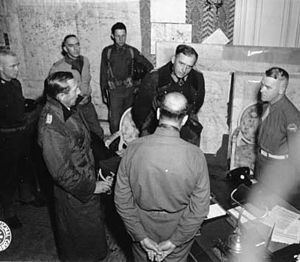Years of service 1915–45 Name Walter Hennecke | Unit SMS FreyaSMS Kaiserin | |
 | ||
Born 23 May 1898Betheln ( 1898-05-23 ) Battles/wars World War IWorld War II Commands held German cruiser Nurnberg, SMS Schleswig-Holstein | ||
Walter Hennecke (23 May 1898 – 1 January 1984) was a German admiral during World War II. He was awarded the Knight's Cross of the Iron Cross by Hitler for "a feat unprecedented in the annals of coastal defense.", when he wrecked Cherbourg's port.
Contents
Imperial Navy and Reichsmarine
Hennecke entered the imperial navy (crew 15) during the First World War on October 2, 1915, as a sea cadet. From 3 October he was commanded to the Marinschule Mürwik and then from 10 November on the large cruiser SMS Freya used as a Training ship. From 6 February 1916 to 9 July 1916 he then served on the grand ship SMS Empress and was then transferred to the Marinschule until February 1917. On July 13, 1916, he was promoted to commander of the sea. From February 1917 onwards Hennecke became a security officer on a Torpedoboot was deployed and on 13 December 1917 he was promoted to Lieutenant. In this function, he experienced the end of the war and was quickly released from the navy. From 5 August 1920, Hennecke was taken over to the Provisional Reichsmarine and continued to serve as guardian and Adjutant. In this function, he was promoted to the rank of lieutenant at sea on 1 January 1921 . From October 1, 1922 to October 15, 1924, Hennecke was then commanded as a company officer for the defense of the coast, and was to join the Technical University of Berlin until September 6,operates. Hennecke served as a teacher at the Schiffsartillerie- Schule (SAS) in Kiel-Wik until 27 September 1927 . From September 30, 1927, he was commandant of the artillery dolphin, and on 1 October 1928 he was promoted to captain lieutenant. From 1 October 1929, Hennecke was once again a teacher, this time at the coast artillery school, and from October 4, 1933 onwards, he received a command as an artillery officer on the light cruiser Nuremberg. Hennecke served as a second admiral staff officer from 17 December 1934 onwardsIn the staff of the Marinestation North Sea. On 1 April 1935 the transport to the Corvette captain took place.
Warmarine
From October 5, 1936, to November 4, 1938, Hennecke was employed as commander of the First Marine Artillery Battalion . He was promoted to frigate captain on August 1, 1938 , and from 2 November 1938 to 30 July 1940 served as first officer on the light cruiser Nuremberg . In November 1938 Hennecke had briefly commanded the ship. Hennecke became the first officer on the 12th of December 1939, after the beginning of the Second World War. He became the captain of the Iron Cross 2nd Class (EK II) and became a captain at sea on 1 February 1940 promoted. On 1 August 1940 Hennecke succeeded the then captain to the sea Ernst Lindemann as commander of the ship artillery school in Kiel-Wik. After his move on October 16, 1941, he directed the school to Sassnitz until April 1, 1943. In addition, from May to October 1941, he was briefly commander of the former cruise ship SMS Schleswig-Holstein, used as a cadet training ship . From 2 April 1943, Hennecke had been appointed Commander of the Maritime Defense Normandy. In this service, he was appointed a countertermiral on 1 March 1944.
Cherbourg
On June 6, 1944, Allied troops landed in the Operation Overlord in an epoch commanded by Hennecke. Hennecke stayed in Cherbourg-Octeville. The German commander-in-chief West Gerd von Rundstedt, had foreseen that the city would be an important strategic destination for the Allies because of its harbor, and ordered the destruction of the harbor on June 9. In his service, Hennecke, together with the city commander General-major Robert Sattler and the harbor commander Captain to the sea Witt, was decisively involved in the complete destruction of the port of Cherbourg, which began on 9 June during the Battle of Cherbourg And only ended immediately before the arrival of Allied troops in the port area on 25 June 1944. After the destruction of the harbor, further military resistance had become meaningless, and so Hennecke surrendered with the German defenders of Cherbourg under the commander-in- chief, Lieutenant-General Karl-Wilhelm von Schlieben, a day later against the 9th US infantry division under General-major Manton S. Eddy in Schlieben's subterranean command bunker in St. Sauveur. The destruction of the port of Cherbourg was regarded as exemplary by the German and Allied parties as the most extensive destruction of a port facility. Hitler was so content with the performance of Hennecke that he gave him the Knight's Cross of the Iron Cross in the war .
Captivity
Hennecke first came into US-American warfare and was transferred on 1 July 1944 to the British general camp Trent Park. On 17 April 1947 he was repatriated. Hennecke died on 1 January 1984 in Bad Lippspringe.
